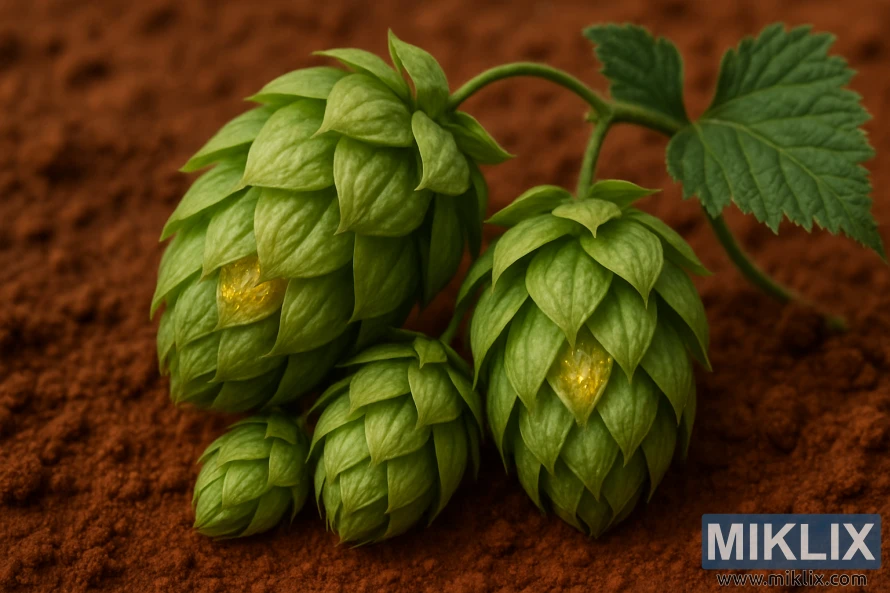Image: Hop Cones with Lupulin Glands
Published: August 9, 2025 at 11:13:26 PM UTC
Last updated: September 27, 2025 at 8:52:52 AM UTC
Close-up of vibrant hop cones revealing golden lupulin glands against earthy red soil, symbolizing natural abundance and complex brewing flavors.
Against the deep, earthy backdrop of red-ochre soil, a cluster of hop cones rests in luminous contrast, their fresh green forms vibrant with life and purpose. Each cone displays the distinctive architecture of papery bracts layered like scales, tapering to delicate tips that curve outward ever so slightly. Nestled within those folds lies the treasure that defines their significance: the golden lupulin glands, visible here as glistening specks of resin peeking through the protective leaves. These tiny reservoirs of oils and acids shimmer subtly under the soft, diffused light, hinting at the wealth of flavor and aroma they hold—the bitterness that balances malt sweetness, the citrus and spice notes that elevate aroma, and the gentle floral undertones that lend elegance to a pint of beer. This intimate view captures not only their physical detail but also the essence of their role in brewing, a bridge between the soil in which they grow and the glass they ultimately enrich.
The soil beneath them is more than background—it is context and foundation. Its warm, rust-red tones evoke fertility, the richness of the land that nurtures hop plants season after season. The rough, granular surface contrasts with the smooth folds of the cones, highlighting the delicate structures that rise from such humble origins. The pairing of cones and soil emphasizes the agricultural reality behind the artistry of brewing, grounding the viewer in the awareness that beer, at its heart, is an agricultural product born from careful cultivation. The soil’s presence here speaks of terroir, of how climate, geography, and farming practices shape the subtle distinctions between hop varieties. It reminds us that every harvest carries the signature of the earth from which it grew.
The lighting adds a quiet reverence to the scene. Neither harsh nor overly dramatic, it falls gently across the cones, revealing the fine veining in the bracts and the slight glossiness of the lupulin resin. Shadows are soft, deepening the folds and adding dimension, while highlights kiss the tips of the cones, creating a balance of clarity and mystery. This interplay of light and shadow invites the eye to linger, to trace the delicate layers of each cone and appreciate the complexity hidden within something so deceptively small. It transforms a simple agricultural image into a meditation on abundance, fragility, and transformation.
The cluster itself speaks of natural abundance, each cone unique yet harmonious within the group. Their slightly varying sizes and shapes suggest vitality, growth, and the organic irregularity of living things. The attached leaves anchor them visually, emphasizing their identity as flowers of the climbing bine that stretches high into trellised fields. They are not isolated objects but part of a greater cycle, from planting to harvest to brewing, and finally to sharing in a communal glass. In this way, the image captures not only the cones themselves but also the continuity of tradition that they represent.
The mood is one of promise, of anticipation. To see hops at this stage is to glimpse them on the threshold of transformation, poised between plant and pint. The golden lupulin within hints at the flavors soon to be coaxed into beer—perhaps a soft, earthy English bitter, a crisp pale ale, or a smooth stout balanced by subtle spice. The possibilities seem infinite, contained within the resin glinting like sunlight captured in miniature. This is the heart of brewing’s magic: that from such small, fragile cones can come such a vast array of tastes, aromas, and experiences. The photograph, in its intimacy and warmth, captures this truth and offers it to the viewer as both a celebration of nature’s ingenuity and a reminder of the deep connection between earth, farmer, brewer, and drinker.
The image is related to: Hops in Beer Brewing: Red Earth

